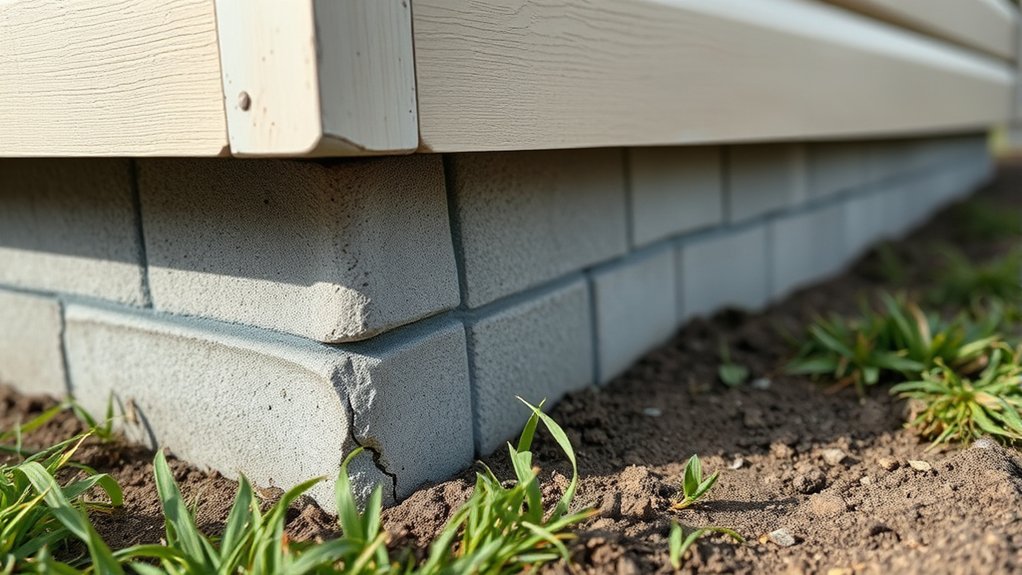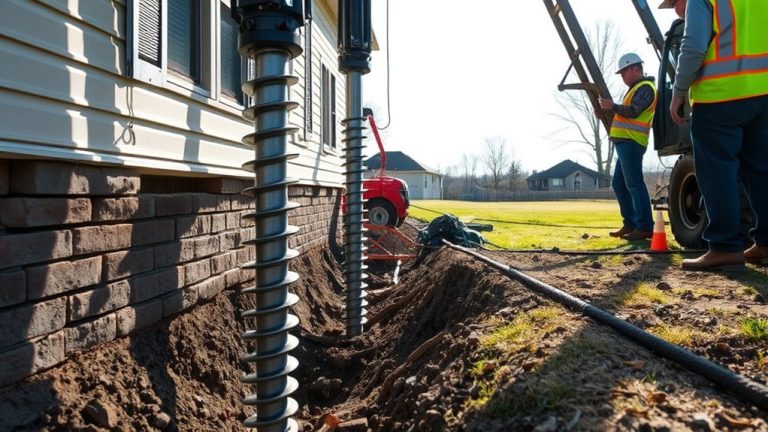Your home's foundation is its silent guardian, but when it starts to sink, trouble follows. Uneven floors, wall cracks, and sticking doors aren't just cosmetic issues—they're warning signs of potential structural damage. If you're noticing these red flags, you'll want to understand what's happening beneath your home and learn how to protect your most prized possession before small problems become costly nightmares.
Key Takeaways
- Look for visible warning signs like diagonal wall cracks, uneven floors, doors that won't close properly, and gaps around window frames, which often indicate foundation settlement.
- Check for structural shifts by examining interior and exterior walls for separation, diagonal cracking, and noticeable sloping in floors that suggest underlying foundation movement.
- Investigate potential causes of foundation problems, including clay soil expansion, poor drainage, underground water movement, and inconsistent soil compaction that can compromise structural integrity.
- Contact a professional foundation inspector when multiple warning signs are present, as they can assess damage, recommend targeted repair strategies, and provide comprehensive diagnostic evaluation.
- Consider repair options based on damage severity, ranging from simple crack sealing ($500) to more extensive solutions like pier installation or slab jacking (up to $15,000).
Common Warning Signs of a Sinking Foundation
If you've noticed some strange changes around your home, it might be time to check whether your foundation is sinking. Foundation cracks near windows, doors, or walls are a telltale sign of potential structural issues.
You might also uncover uneven floors that slope or feel unstable when you walk across them. Exterior brick walls with diagonal cracks, gaps around window frames, or doors that no longer close properly could indicate foundation problems.
These warning signs suggest your home's foundation might be shifting, settling, or experiencing significant stress that requires professional assessment. Hydrostatic pressure from poor drainage and surrounding soil can contribute to serious foundation damage that compromises your home's structural integrity.
Understanding Structural Shifts and Settlement
When foundation problems emerge, understanding structural shifts becomes essential for homeowners concerned about their property's stability. Settlement occurs naturally as soil compaction changes, but excessive movement can signal serious issues. Foundation cracks indicate potential structural vulnerabilities that require professional assessment. You'll want to monitor how your home's foundation responds to environmental factors like moisture management and ground conditions. Uneven settling can cause walls to crack, floors to slope, and doors to stick. These shifts aren't just cosmetic—they can compromise your home's structural integrity.
Types of Foundation Damage to Watch For
Foundation damage isn't just about surface-level cracks—it's a complex issue that can threaten your home's structural health. You'll want to watch for telltale signs like uneven floors, wall separations, and sticking doors or windows. These symptoms often indicate serious underlying problems that require professional assessment.
Consider drainage system upgrades to prevent water-related foundation stress, and investigate underpinning techniques if significant settlement occurs. Don't ignore minor warning signs, as they can quickly escalate into major structural challenges. Early detection and proactive intervention can save you thousands in repair costs and protect your home's long-term stability.
When to Call a Professional Foundation Inspector
Most homeowners should consider scheduling a professional foundation inspection when they've noticed multiple warning signs of potential structural issues. If cracks are spreading, doors are sticking, or floors seem uneven, it's time to call an expert.
Professional inspectors can provide extensive assessments and recommend targeted solutions. They'll conduct thorough evaluations using specialized equipment, offering continuous monitoring and detailed insights into your home's structural health. Scheduled inspections can catch problems early, potentially saving you thousands in repair costs and preventing more serious damage to your property.
DIY Foundation Assessment Techniques
Home foundation issues can sneak up on unsuspecting homeowners, making regular self-inspections a crucial preventative strategy. You can perform a simple foundation assessment by walking around your property and looking for telltale signs of potential problems.
Check for horizontal or stair-step cracks in exterior walls, uneven floors, and doors that stick or won't close properly. Measure and document any visible foundation gaps or shifts. A visual foundation inspection can reveal early warning signs before they become expensive repairs.
Don't ignore small changes—they often signal bigger underlying issues that could jeopardize your home's structural integrity.
Potential Causes of Foundation Problems
After carefully examining your property for signs of foundation distress, you'll want to understand what might be causing these structural shifts. Soil compaction is often the primary culprit, where ground moisture and weight cause uneven settling that stresses your home's foundation.
Clay soils are particularly problematic, expanding and contracting with temperature changes. Poor drainage, inadequate structural reinforcement, and underground water movement can also contribute to foundation problems. Tree roots, plumbing leaks, and extreme weather conditions further destabilize your home's base, creating potential long-term structural risks that demand immediate attention.
Repair Options and Cost Considerations
Foundation repairs can quickly escalate from minor adjustments to major structural interventions, depending on the severity of the damage. You'll want to examine affordable repair options that match your budget and home's specific needs. Costs can range from $500 for simple crack sealing to $15,000 for thorough foundation work.
Professional inspections help you plan long-term cost strategies and prevent more expensive future repairs. Consider methods like pier installation, slab jacking, or waterproofing, which can stabilize your foundation and protect your investment. Always get multiple quotes and understand each repair's potential long-term benefits before committing.
Preventative Maintenance for Long-Term Foundation Health
Most homeowners can protect their property's foundation through strategic, proactive maintenance that prevents costly structural damage. Regular inspections are your first line of defense against foundation problems. You'll want to schedule professional evaluations annually to catch potential issues early.
Check for signs of soil erosion, water drainage problems, and small cracks that could indicate deeper structural concerns. Maintain consistent moisture levels around your foundation by using proper landscaping techniques, installing gutters, and ensuring proper grading. By investing a little time and effort now, you'll save thousands in potential repair costs later.
Frequently Asked Questions
Can a Sinking Foundation Cause My Home's Value to Decrease?
Yes, a sinking foundation can substantially decrease your home's property value, especially if you don't address foundation stabilization costs early, potentially reducing your freedom to sell at market price.
How Long Does a Typical Foundation Repair Process Take?
You'll typically spend 1-3 days on foundation inspection and structural engineer evaluation, with total repair processes ranging from a few weeks to several months, depending on your home's specific damage and repair complexity.
Will My Homeowner's Insurance Cover Foundation Damage and Repairs?
Your foundation repair coverage depends on your specific insurance policy limitations. Most standard policies won't cover damage from settling or gradual wear, but sudden events like earthquakes might be included.
Are Older Homes More Susceptible to Foundation Sinking Problems?
Yes, older homes are more prone to foundation sinking due to aging foundation materials and shifting soil composition. You'll want to monitor your property's structural integrity and address potential issues proactively.
Can Foundation Issues Lead to Dangerous Living Conditions?
Foundation issues can compromise your home's structural integrity risks, creating dangerous health hazards like mold, unstable floors, and potential collapse that threaten your family's safety and personal freedom.

